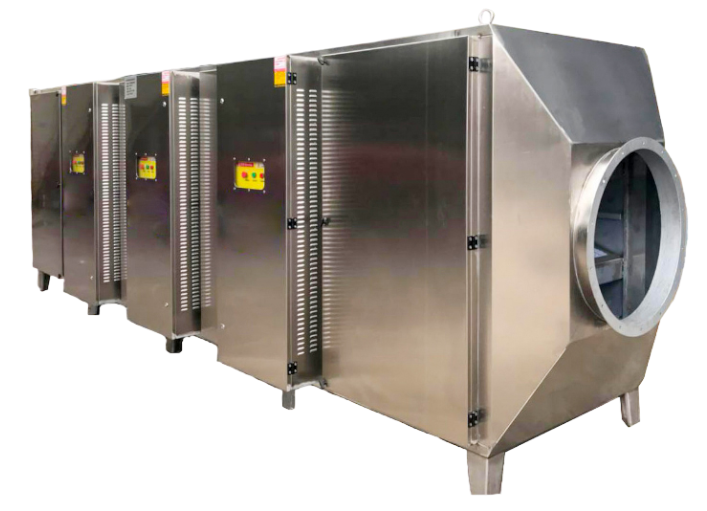DEODORIZER
เครื่องกำจัดควัน
เครื่องกำจัดควันและกลิ่นด้วยพลาสมาอุณหภูมิต่ำ เทคโนโลยี Low Temperature Plasma Exhaust Gas Treatment เป็นเทคโนโลยีการกรองที่ใช้พลาสม่าซึ่งเป็นสถานะที่สี่ของสสารหลังจากแข็ง, ของเหลว, และแก๊ส เพื่อสลายโมเลกุลในแก๊สไอเสีย โดยการปล่อยพลังงานไฟฟ้าความถี่สูงและแรงดันสูงจะทำให้เกิดพลาสม่าและสลายแก๊สไอเสียอย่างรวดเร็ว

หลักการทำงานของเครื่อง Deodorizer
1. พลาสมาเป็นสถานะที่สี่ของสสารและถูกสร้างขึ้นโดยการปลดปล่อยไฟฟ้าความถี่สูงและแรงดันไฟฟ้าสูง พลาสมานี้สามารถทำลายโมเลกุลอากาศและก๊าซเสีย ผลิตก๊าซที่มีปฏิกิริยา เช่น เรดิคัลฟรีและไอออน รีดิคัลฟรีเหล่านี้สามารถทำลายไวรัสและแบคทีเรียได้โดยการขัดขวางกระบวนการเมตาบอลิสม์ของมัน พลาสมายังสามารถย่อยสลายหรือลดโมเลกุลกลิ่นอินทรีย์ รวมถึงดูดซับและจัดการกับอนุภาคอินทรีย์ขนาดเล็กได้อย่างมีประสิทธิภาพ
2. พลาสมาอุณหภูมิต่ำมีลักษณะโดยมีอุณหภูมิอิเล็กตรอนสูงในกระบวนการปลดปล่อย แต่มีอุณหภูมิของอนุภาคหนักต่ำ ส่งผลให้สภาพอุณหภูมิโดยรวมของระบบต่ำ การย่อยสลายมลพิษได้ผ่านการโต้ตอบของอิเล็กตรอนที่มีพลังงานสูง เรดิคัลฟรี และอนุภาคที่มีปฏิกิริยาอื่นๆ กับมลพิษในก๊าซเสีย นำไปสู่การย่อยสลายอย่างรวดเร็วและทำปฏิกิริยาต่อเนื่อง
3. กระบวนการพื้นฐานของการย่อยสลายมลพิษด้วยพลาสมาอุณหภูมิต่ำประกอบด้วยขั้นตอนดังนี้
ขั้นตอนที่ 1 การถูกยิงโดยตรงด้วยอิเล็กตรอนที่มีพลังงานสูง
ขั้นตอนที่ 2 การออกซิเดชันของอะตอม O หรือโอโซน O2+e เป็น 20
ขั้นตอนที่ 3 การออกซิเดชันของ H20+e, OH+H, H20+0, 2HO, H+02 เป็น OH+0 ของเรดิคัลฟรี OH
ขั้นตอนที่ 4 การปฏิกิริยาของเศษโมเลกุล + การออกซิเดชัน
4. การจัดการกับก๊าซเสียที่ยังไม่ได้รับการปฏิบัติมีการใช้โฟโตแคทตาลิสต์พิเศษ TiO2 เพื่อออกซิเดชันฝ้ายกรองไฮโดรเจน การรวมกันนี้กับโอโซน, ออกซิเจนทางเศรษฐกิจ และเรดิคัลฟรีที่มีปฏิกิริยา นำไปสู่การทำความสะอาดหลายระดับของก๊าซเสียอันตราย เช่น ก๊าซเสีย ก่อนที่จะถูกปล่อยออกไป
กำจัดก๊าซเสียด้วยเทคโนโลยีขั้นสูง
ระบบกรองนี้เหมาะสำหรับการบำบัดก๊าซไอเสียจากสารอินทรีย์ในโรงงานอุตสาหกรรม มีการออกแบบที่มุ่งเน้นการทำงานอย่างมีประสิทธิภาพและปลอดภัย ความสามารถในการบำบัดแก๊สไอเสียประสิทธิภาพสูง.
- มีประสิทธิภาพการกรองที่สูงและสามารถกรองสารปนเปื้อนได้ในเวลาเดียวกัน
- ประสิทธิภาพการป้องกันไฟไหม้ใช้สวิตช์, พาวเวอร์, วงจรป้องกันอัตโนมัติ
- ขนาดเครื่องกรองเล็กและมีโครงสร้างที่กะทัดรัด
- ค่าใช้จ่ายในการลงทุนต่ำและต้นทุนการดำเนินการต่ำ
- ปลอดภัยและง่ายต่อการบำรุงรักษา มีอายุการใช้งานยาวนาน
- ประสิทธิภาพการกรองสูงโดยไม่มีมลพิษ
แนะนำผลิตภัณฑ์
เครื่องบำบัดก๊าซเสียพลาสมา Deodorizer รุ่น WT Series ใช้การออกแบบเทคโนโลยีที่ไม่ซ้ำใครในการดูดซับและการย่อยสลายก๊าซเสียโดยกระบวนการคาร์บอนไนเซชัน นำเสนอข้อดีของเทคโนโลยีมาตรฐานและหน่วยการย่อยสลายประเภทแห้ง การเปลี่ยนแปลงอุปกรณ์การบำบัดก๊าซเสียอินทรีย์ได้เปลี่ยนวิธีการใช้วัสดุคาร์บอนที่ถูกปฏิบัติต่อไป ไม่มีมลพิษที่ต้องรับผิดชอบ ง่ายต่อการเปลี่ยนและบำรุงรักษา การติดตั้งง่ายและสามารถประยุกต์ใช้กับอุปกรณ์อื่นๆ ได้
มีรูปแบบและขนาดที่หลากหลายเพื่อให้เหมาะกับสถาพแวดล้อมของหน้างานลุกค้า มีโครงสร้างที่กะทัดรัด ลงทุนน้อยและสะดวกในการใช้งาน ผลิตภัณฑ์ทำจากวัสดุมาตรฐานและสแตนเลสสตีล มีปริมาตรลม 6000-60000 m³/h ผลิตภัณฑ์นี้เป็นเทคโนโลยีใหม่สำหรับการรักษาก๊าซเสียอินทรีย์ในอุตสาหกรรม
| Model | Equipment size (length and width ) | Equipment configuration | Voltage | Power | Inlet and outlet size | Equipment material |
| WT -5000 | 1200x900x900 | 2 groups of electric fields ,1 groups of high frequency low temperature plasma power supply .1 sets of electric control box ,current automatic protection device ,temperature induction controller ,air inlet and outlet filter screen . | AC voltage 220 | 0.6KW | 500×600 | Wire drawing stainless steel |
| WT -10000 | 1200x1100x1000 | 2 groups of electric fields ,2 groups of high frequency low temperature plasma power supply .1 sets of electric control box ,current automatic protection device ,temperature induction controller ,air inlet and outlet filter screen . | AC voltage 220 | 1.6KW | 700×700 | Wire drawing stainless steel |
| WT -15000 | 1700x1300x1300 | 8 groups of electric fields ,4 groups of high frequency low temperature plasma power supply .2 sets of electric control box ,current automatic protection device ,temperature induction controller ,air inlet and outlet filter screen . | AC voltage 220 | 2.4KW | 900×1000 | Wire drawing stainless steel |
| WT -20000 | 1700x1500x1500 | 8 groups of electric fields ,4 groups of high frequency low temperature plasma power supply .2 sets of electric control box ,current automatic protection device ,temperature induction controller ,air inlet and outlet filter screen . | AC voltage 220 | 3.2KW | 1100×1200 | Wire drawing stainless steel |
| WT -30000 | 2800x1600x1600 | 12 groups of electric fields ,6 groups of high frequency low temperature plasma power supply .3sets of electric control box ,current automatic protection device ,temperature induction controller ,air inlet and outlet filter screen . | AC voltage 220 | 3.6KW | 1200×1300 | Wire drawing stainless steel |
| WT -40000 | 2800x1950x1700 | 12 groups of electric fields ,6 groups of high frequency low temperature plasma power supply .3 sets of electric control box ,current automatic protection device ,temperature induction controller ,air inlet and outlet filter screen . | AC voltage 220 | 4.8KW | 1550×1400 | Wire drawing stainless steel |
